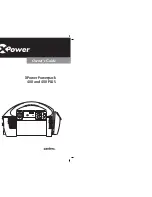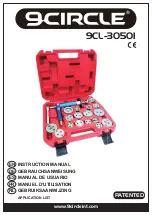
Page 7
SKU 40039
Operation
7. Check again to make sure your workpiece is secure and draw a cutting line on it. Re-check
the condition of your blade.
8. Plug in the Jig Saw.
9. Test the Jig Saw without a load by gently squeezing the Trigger (#2a). Run it on high (fully
depressed) for a few minutes. Then, test the lock mechanism by starting the Jig Saw and
then engaging the Lock Button (#3a). To disengage the Lock Button (#3a) squeeze the
Trigger (#2a).
10. To begin cutting, first bring the blade up to speed by depressing the Trigger (#2a) before
contacting the workpiece.
11. Set the front of the Base (#37) on the beginning of your cutting line.
12. Slowly make contact letting the Jig Saw do the work. Just guide the saw. If the Jig Saw
is not cutting to your satisfaction try using the Adjustment Nut (#4a) to compensate.
If it still does not cut to satisfaction, make sure you have a straight, sharp blade with no
cracks.
Note: If the Jig Saw seizes in a workpiece, shut it off and unplug it. Try to work out the blade.
If necessary, remove the blade from the saw and remove the blade from the workpiece.
Before replacing the blade, make sure it is in satisfactory condition.
13. When finished cutting, release the Trigger (#2a) and unplug the Jig Saw.
1. Secure your workpiece in a vice or clamp it to a work bench. Make sure the blade path
below the workpiece is clear of obstacles.
2. Choose the appropriate blade for the material you will be cutting. Blades for cutting soft or
hard metals, and wood cutting blades are available at Harbor Freight Tools.
3. Attach the blade following the instructions above.
Note: This Jig Saw has three adjustment features.
4. The number of strokes per minute (0 - 3100) is determined by adjusting the Adjustment
Nut (#4a). Turning toward the + sign increases the strokes, and turning toward the - sign
decreases the strokes. Use the highest number of strokes possible for cutting soft materials
such as wood, and use a low number of strokes when cutting hard materials like metal.
Note: Steel requires a liquid coolant while cutting. Practice on scrap pieces to learn the stroke
adjustment appropriate to your needs.
Note: You may adjust when the Jig Saw is running or off.
Note: The Jig Saw heats up rapidly when cutting at a slow rate. Periodically, set the stroke
setting to high, and run the saw for a few minutes without a load to cool the saw.
5. There is also a pendulum adjustment Lever (#7a). It adjusts the movement of the blade
path according to the material you are cutting. For soft materials such as wood, set the
Lever (#7a) to number 3. For hard materials such as steel, set the Lever (#7a) to 0 or to 1.
For thin-walled materials set the Lever (#7a) to 0. Always set the Lever (#7a) adjustment after
the blade is attached. It takes practice to learn to skillfully use the pendulum
adjustments. Practice on scrap pieces.
6. You may also adjust the cutting angle of the Base (#37). Loosen the Fixing Screw (#13a).
Turn the Base (#37) to the required angle. It has stops for 15, 30, and 45 degrees, but you may
set it anywhere in between. Tighten the Fixing Screw (#13a).
CAUTION: Keep fingers and hands a safe distance from blade at all times while cutting.
Rev 01/03
Содержание 40039
Страница 10: ...Page 10 SKU 40039 Assembly Drawing Rev 01 03 ...




























